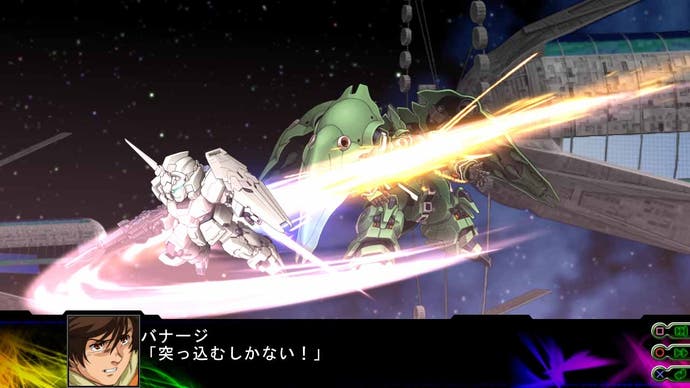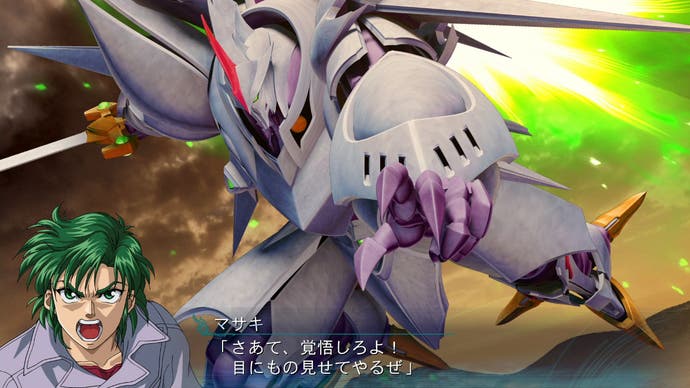All is fair in love and Super Robot Wars
Dissecting the history of one of Japan's most enduring mecha series.
Back in 1991 the GameBoy was well into its swing, and all manner of new publishers were getting in on the action. Not wishing to miss a trick, Banpresto released a relatively small turn-based strategy game developed by a tiny studio by the name of winkysoft. It was called Super Robot Taisen (aka Super Robot Wars, or SRW for short).
Unlike other turn based strategy games such as chess, the pieces on this game's board stemmed from a separate long-running pantheon. Calling up on nearly half a century of pop culture mythos, the pieces came from various mecha anime.
Despite having "super robot" in the title, only some of the game's units were actually "super". This is because mecha are broken down into various types in anime, with the two main categories of "super" and "real".

Super robots are the kind that are piloted by feral pilots with big hair that scream a lot and defeat the baddie of the week by just deciding to do so after a protracted fight. Real robots are treated more like actual machines, with limited parameters and rules they have to work within. Much of Western mecha design is heavily influenced by this latter approach.
Having "super robots" in a game was somewhat of a big deal because they don't obey rules in the strictest sense. That in turn runs counter to a game, which generally are based on a set of interconnecting rules. So to have supers in a GameBoy title back in 1991 was worthy of bragging rights, hence why the name stuck (despite real robots also being present).
The reason why super robots could exist in the game at all was how winkysoft decided to handle them. Due to the turn based strategy nature of the game, it meant you could have both real and super robots square off, as the only action was to do with moving the pieces in range of one another. The actual attacks were then detached from the game.
Originally this was a very simple side-on view with non-animating cutesy super deformed sprites dealing damage to one another. Over time this aspect of the games became more overt and ostentatious, resulting in increasingly elaborate and impressive battle animations.
As the games progressed, the strategy required by the player in each incarnation became increasingly exacting, culminating in Super Robot Wars F and F Final - two fiendishly difficult tomes of strategy made even more complex due to the steadily increasing roster of anime series and units they produced.

This is one of the most important aspects of the Super Robot Wars games; unlike chess the pieces aren't set from game to game but change and grow. You can have hundreds of units under your control in any given encounter and each unit is bespoke in terms of what it can do. Added on to this are the respective pilots of each unit (with their own abilities as well).
Managing all this and understanding why several of your enemy's aura battlers have decided to go into hyper mode is what makes the Super Robot Wars games so compelling. It's not just about being a good strategist; it's about knowing what anime each of your units and enemies have come from, and what they can and will do on account of that.
This is where the battle animations come into their own, as the newer games have opted to actually show each unit undertake their attacks. Admittedly you can choose not to watch, but to skip them feels somewhat of a crime. To say that a lot of love has been poured into these animations doesn't really do them justice.
Couple this with the player's increasing knowledge of their now favourite mecha anime, as Bandai and Banpresto don't miss a trick with this kind of cross promotion, and you have a very potent mix of seeing your mecha heroes bro-fisting to victory as you undertake a very difficult battle of strategy.

Another fascinating aspect of the Super Robot Wars games is that, due to their cross title pollination, you often need an overarching story that connects all these disparate series to work together. This means we've already had several sagas over the years, from the Alpha games to the more recent Z series. This is also where the Original Generation (or OG) units also come in.
Unique to each of the games, these are special units that were not from any licensed anime or game but instead created solely for that entry of Super Robot Wars. With each entry the roster of these units has reached critical mass, resulting in multiple spin-off games that solely feature the OG units.
One of the more famous standalone OG series is that of the Masou Kishin titles, that predate the OG games in fact. These were interesting in their fantasy approach, rather than the typical sci-fi that's more common with real and super robot anime - as well as their choice to depict the mecha to scale and not super deformed. The first of these games was a Super Famicom title that had a serious cult following in Japan. This then resulted in more recent DS and PSP ports, followed by an eventual PSP and PS3 set of sequels. All of these were developed by winkysoft and like F and F Final they are brutal games compared to the more modern licensed entries.

The Super Robot Wars series hasn't always resulted in brilliance though. Some of the 3D entries have been pretty unfortunate, not only in terms of the sub-par battle animations but also turgid strategy setups. Then there are the multiple aborted attempts at action tie-ins, such as Real Robots Final Attack and the painful Infinite Battle (though From Software's initial Another Century's Episode games on PS2 are excellent, though avoid the PS3 game as it's pretty disappointing, the PSP port is decent however).
The other main problem with Super Robot Wars is that due to the licensing issues, bar a few OG games on GBA and DS (as Banpresto own all the rights for those), releases of these games abroad in English are highly unlikely. This means you have to undertake a complex strategy game in Japanese based on a variety of anime you'll likely never see. Some fans have done the decent thing and tried to translate a few classics but it's not the same really.
Originally intended as a mere mecha anime crossover vehicle, Super Robot Wars has become something else. Not only has it facilitated new generations of gamers to discover brilliant anime from times long past, but also birthed unique games and anime in their own right. This being pretty damn impressive when the whole series started out as a small little GameBoy game at the dawn of the 90's. So hang in there in roboto-chan, it looks like your future is bright and full of hardcore key-framed battle animation heroics.








